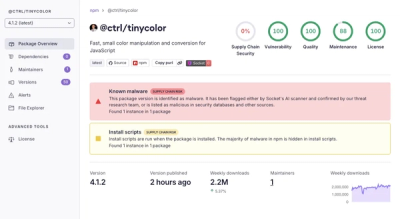
Research
/Security News
Popular Tinycolor npm Package Compromised in Supply Chain Attack Affecting 40+ Packages
Malicious update to @ctrl/tinycolor on npm is part of a supply-chain attack hitting 40+ packages across maintainers
node-tunnel
Advanced tools
HTTP tunneling proxy library.
Install node-tunnel by running:
$ npm install node-tunnel
Function that creates a connection between the tunnel and the target server.
It defaults to Promise.method(net.connect) which returns Promise<net.Socket>.
Kind: method of Tunnel
Summary: Establish the upstream connection.
Access: public
Example
// Create a tunnel with a custom connect method
tunnel = new Tunnel();
tunnel.connect = (port, host, client, req) => {
console.log(`Establishing tunnel to ${host}:${port}...`);
return Promise.method(net.connect);
};
Use a middleware function for rewriting request destination (by changing req.url), add authorization or filter connections to only certain hosts and ports.
The parameters are the same as the http module passes on "connect" event, plus a callback function similar to express middleware.
Keep in mind that express middleware do not work with in conjunction with this module.
Kind: method of Tunnel
Summary: Use a middleware.
Access: public
Example
// Start a tunneling proxy on port 3128
tunnel = new Tunnel();
tunnel.use( function(req, cltSocket, head, next) {
// Send all connections to port 80 of localhost.
req.url = "http://localhost:80";
next();
} );
tunnel.listen(3128)
Start listening on the given port. An optional callback function is called when tunnel is ready to listen.
Kind: method of Tunnel
Summary: Start listening.
Access: public
Example
tunnel = new Tunnel();
tunnel.listen(3128, function() {
console.log("Tunnel listening on port 3128");
});
Parses Proxy-Authorization header and sets req.auth.username and req.auth.password properties.
Further middleware should be added to accept or reject connections based on this authentication information.
Kind: method of Tunnel
Summary: Parse Proxy-Authorization header.
Access: public
Example
tunnel = new Tunnel();
tunnel.use(basicAuth);
tunnel.use( function(req, cltSocket, head, next) {
if (req.auth.username != "user" || req.auth.password != "password") {
cltSocket.end() // close connection
return; // no further middleware need to be called
}
next();
} );
tunnel.listen(3128, function() {
console.log("Tunnel listening on port 3128");
});
If you're having any problem, please raise an issue on GitHub and the Balena team will be happy to help.
Run the test suite by doing:
$ npm install && npm test
Before submitting a PR, please make sure that you include tests, and that coffeelint runs without any warning:
The project is licensed under the MIT license.
4.0.8 - 2025-04-10
FAQs
Http tunneling proxy
We found that node-tunnel demonstrated a healthy version release cadence and project activity because the last version was released less than a year ago. It has 1 open source maintainer collaborating on the project.
Did you know?

Socket for GitHub automatically highlights issues in each pull request and monitors the health of all your open source dependencies. Discover the contents of your packages and block harmful activity before you install or update your dependencies.

Research
/Security News
Malicious update to @ctrl/tinycolor on npm is part of a supply-chain attack hitting 40+ packages across maintainers

Security News
pnpm's new minimumReleaseAge setting delays package updates to prevent supply chain attacks, with other tools like Taze and NCU following suit.

Security News
The Rust Security Response WG is warning of phishing emails from rustfoundation.dev targeting crates.io users.